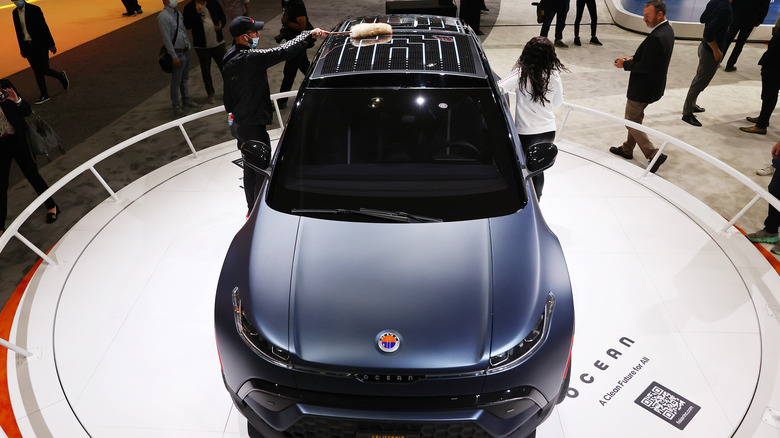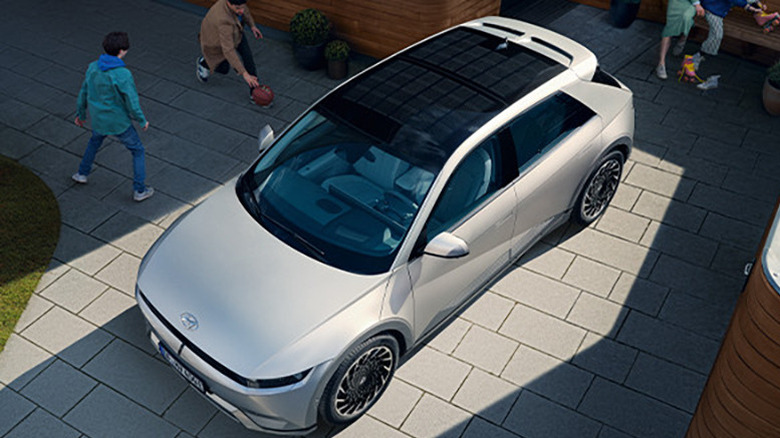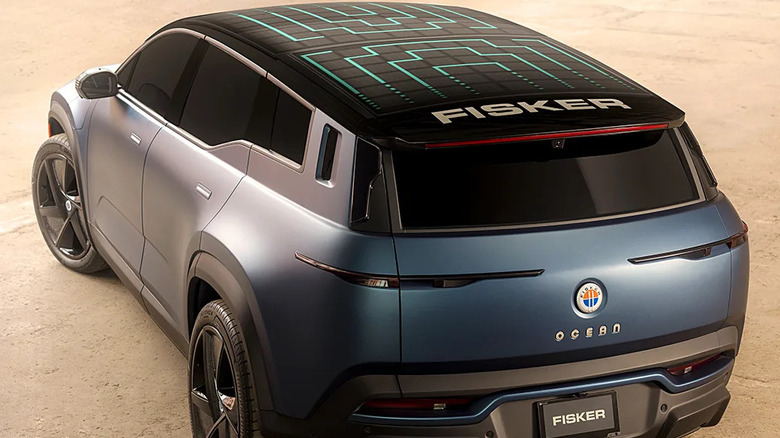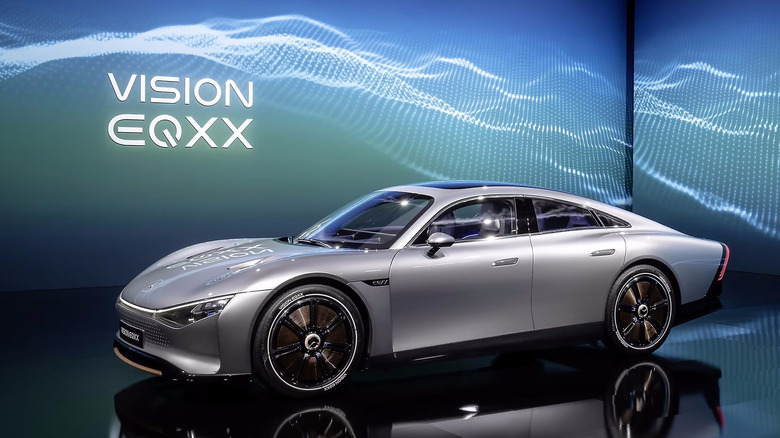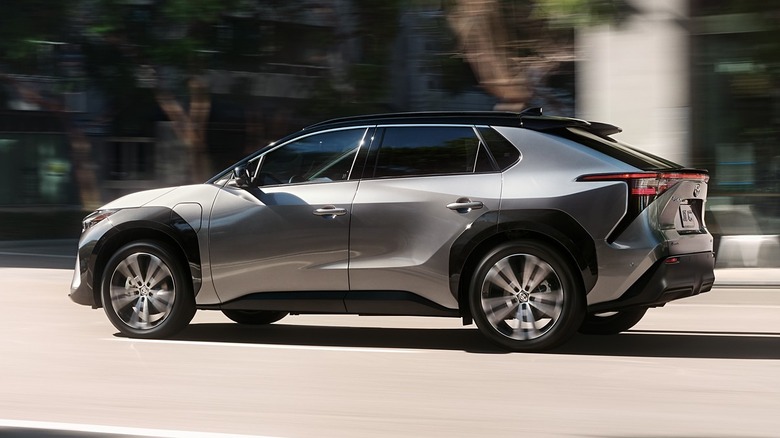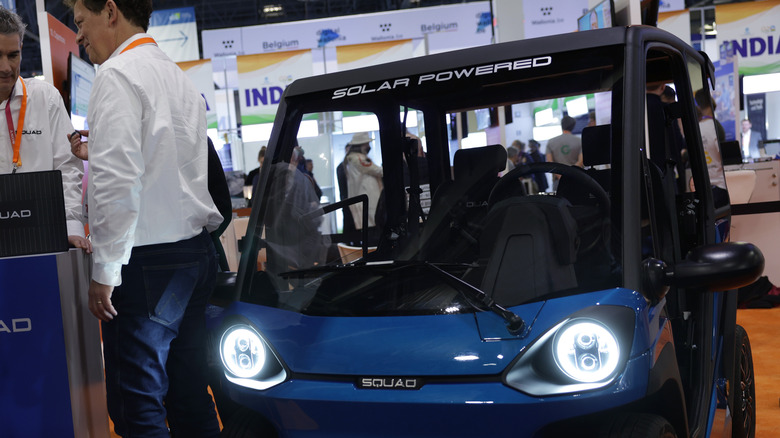5 Of The Coolest Electric Cars With Solar Panel Roofs
Electric vehicles have obvious advantages in terms of their positive impact on air pollution and fuel savings, but two oft-cited barriers to entry are slow charging speeds and the lack of charging stations in rural areas. A forward-looking solution some automakers are implementing is the use of solar panels on the roof of their EVs, along with an inverter inside the vehicle to charge the batteries.
Although this adds some weight and complexity to the vehicle as well as introducing a couple of potential points of failure into the charging system, it's a sustainable way to keep an EV charged without worrying about finding a charging station or relying on an expensive home setup.
The limits of solar charging for cars are the same as for home power: Solar panels are not made of easily recycled materials, and the ability to generate power is affected by cloud and tree cover as well as the duration of daylight hours. For example, someone living in Iceland or Alaska may only see the sun for a few hours each day during the winter months. Still, solar recharging for EVs is an intriguing idea, and there are a handful of cars on the market today or on the way shortly that offer this option.
Hyundai Ioniq 5
Hyundai introduced the original Ioniq in 2016 in three variants: hybrid, plug-in hybrid, and EV. The Ioniq 5 EV came along in 2021, but Hyundai only sold 153 Ioniq 5s to American buyers that year. That figure skyrocketed to nearly 23,000 units in 2022, making the Ioniq 5 the seventh-best-selling EV in the U.S. that year. Sales jumped again last year, to just under 34,000 cars. The Ioniq 5's headliner, carpeting, and seat covers are made from recyclable sugar cane-based materials, and the long wheelbase and short overhangs are designed to protect the occupants and batteries in the event of a crash. Interior highlights include a 12.3-inch digital dashboard, and an equally-sized infotainment screen of equal size that has Apple CarPlay and Android Auto capability.
The Ioniq 5 also employs Hyundai's vehicle-to-load charging system, which allows owners to use the car to charge another EV or power home appliances in an emergency. The rooftop solar panels are an option on the Ioniq 5, and add up to 6 kilometers per day to the Ioniq 5's range of roughly 375 km (233 miles).
Slashgear tested the upcoming 2025 Ioniq 5N, but there is no word yet if this 600-horsepower marvel will be offered with the solar panel option.
Fisker Ocean Extreme
Danish born former BMW design executive, Henrik Fisker, founded the second car company to bear his name in 2016. His first foray into the industry produced one vehicle, the 2012 Fisker Karma. That electric car was given a failing grade by Consumer Reports, which panned its "poor dash controls, limited visibility, a cramped interior, awkward access ... engine that is noisy when running, long battery recharge times, and small backseat and trunk."
Fisker seems to have ironed out most, if not all, of those issues with his latest effort, the Ocean SUV. Fisker unveiled the Ocean at the 2020 Consumer Electronics Show in Las Vegas, and Time Magazine, CNET, and Business Insider all put it on their lists of the best products from that year's show.
The 2024 Ocean comes in three trim levels, but only the top-tier Extreme version includes the SolarSky rooftop panel array. The SolarSky panels cover the entire roof of the Ocean, and Fisker claims the panels can provide more than 2,000 extra miles a year in ideal environments. Like the Ioniq 5, the Ocean can be used to charge another EV or power home appliances in the event of an outage.
Fisker boasts a maximum range of 440 miles and a 0-60 time of 3.7 seconds with the peak power option, which provides 564 horses worth of oomph to the dual motors. The interior highlights include a 17.1 inch rotating touchscreen and a Harman/Kardon sound system.
Mercedes Vision EQXX
Mercedes-Benz built the sleek, futuristic EQXX using sustainable materials derived from cactus, mushrooms, and recycled water bottles. Most of those plant-based fibers and recycled plastics are used in the car's interior, but Mercedes also tried to keep energy consumption low at every stage of the EQXX's construction, and it built the car with the goal of maximizing range and charging efficiency.
Part of that design strategy included limiting the car's weight and making it as aerodynamic as possible. These measures helped the EQXX travel more than 1,000 kilometers on a single charge during a test run across Europe. The rooftop solar panels are currently configured to only power 12 volt systems in the car — such as the infotainment panel, lights, and climate control fan — but that contribution adds about 25km of range to the car's capacity by removing that load from the main battery bank. Slashgear's Chris Davies drove an EQXX prototype in October 2022 and called it "arguably the most compelling Mercedes I've driven in a decade."
As a concept car, it's unlikely the Vision EQXX will make it to market, however, Mercedes was able to show off features derived from the EQXX in a new CLA four-door sedan demonstrated at the Munich Motor Show in September 2023, with a final product expected to go on sale in the U.S. in 2025.
Toyota bZ4X
Toyota welcomed hybrid technology into the mainstream when it introduced the Prius in Japan in 1997 and brought it to North America in 2000. Almost a quarter of a century later, there are almost 2.5 million electric vehicles on American roads, and they accounted for more than $49 billion in sales in 2023. Although Toyota was at the forefront when it came to hybrids, it didn't produce an EV until it introduced the bZ4X in the spring of 2022 as a 2023 model. The 2024 bZ4X improves on that effort with rooftop solar panels, water-cooled batteries, and a maximum range of just over 250 miles.
The single motor in the front-wheel drive version produces 201 horsepower and 196 pound-feet of torque, and upgrading to the dual-motor AWD drivetrain ups the output to 214 horsepower and 248 pound-feet of torque. Front seat occupants can browse maps and manage audio and climate control systems via the 12.3 inch touchscreen, and the driver can access vehicle data, outside temperature, and more via the display located above the steering column. Driver assist features include blind spot monitoring, safe exit assist, and front and rear parking assist with automatic braking.
Squad Mobility Solar City Car
Netherlands-based Squad Mobility was founded by Robert Hoevers and Chris Klok in 2019 and has been selling its solar-powered City Car in Europe since the spring of 2022. The City Car is classified as an L6e vehicle in the European Union, meaning it does not require a driver's license to operate. It has two seats, removable doors, a roof and windshield, and a protective roll cage. The 2 kilowatt in-wheel rear motors are powered by four removable 1.6 kWh lithium-ion battery packs. With all four packs installed and fully charged, the City Car has a top speed of 28 mph and a range of 62 miles.
The rooftop solar panel should provide up to 13 miles a day of range even without charging the batteries, and Hoevers told Electrek the company is currently taking preorders from United States customers for delivery in 2025. "We are seeing a tremendous interest from the United States, specifically for markets such as golf cart communities, (corporate) campuses, sharing platforms, hotels and resorts, amusement parks and inner-city services."
